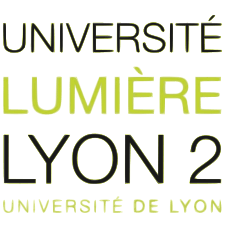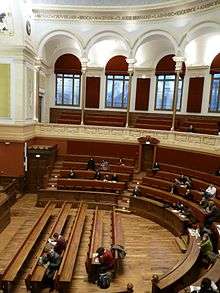Lumière University Lyon 2
Lumière University Lyon 2 (French: Université Lumière Lyon 2) is one of the three universities that comprise the current University of Lyon, having splintered from an older university of the same name, and is primarily based on two campuses in Lyon itself. It has a total of 27,500 students studying for three-to-eight-year degrees in the arts, humanities and social sciences.
Université Lumière Lyon 2 | |
 | |
| Motto | Inter Folia Fulget [1] |
|---|---|
Motto in English | The knowledge between pages |
| Type | Public |
| Established | 1835[2] |
| Endowment | €121 M |
| President | Nathalie Dompnier |
| Students | 27,393 |
| Undergraduates | 14,851 |
| Postgraduates | 7,046 |
| 1,355 | |
| Location | , France |
| Campus | Urban |
| Affiliations | University of Lyon |
| Website | www.univ-lyon2.fr (In English) |
History
At the end of the 18th century, Lyon did not have a university. Education was still linked to religious congregations and influenced by the town's commercial, scientific and industrial requirements.
- 1835 and 1838 : Creation of the Faculties of Science and Humanities.
- 1874 and 1875 : Creation of the Faculties of Medicine and Law.
- 1896 : All these faculties were combined to form the University of Lyon. The same year, the historical buildings on the left bank of the Rhone were finished, initially dedicated to the faculties of medicine and science, then to the faculties of law and humanities. University of Lyon 2 is now established in part of these buildings.
- December 1969 : University Lyon 2 was created as a result of the Loi Faure of 1968, according to which each university must be a legally independent establishment. It comprised law, humanities and social sciences. The number of students soon rose significantly. In such a demographic context, the University was extended in Bron, where a new campus was built during the 1970s, its original features included a modular organisation, a street within the university and a landscaped environment. For some years now, it has been part of the developing area of Porte des Alpes near Bron.
- 1987 : University Lyon 2 was renamed University Lumière Lyon 2. The logo was created by the Art and Design School of Lyon reflecting the University's new ambitions: offering optimal access to the foundations of culture, promoting initiatives and opening itself to the world.
- Today : University Lumière Lyon 2 extends over two main sites :
- Berges du Rhône, the historic site in the centre of Lyon on the left bank of the Rhone, the head office of the University;
- Porte des Alpes, on the south-eastern outskirts of Lyon, in Bron and Saint-Priest which houses the teaching and research premises and the buildings of the polytechnic institute (IUT Lumière) as well as cultural and sports activities.
Notable professors
- Robert Faurisson – French academic and arts teacher today redeemed, above all known as activist and Holocaust denial author.
- Jacques Bichot – French economist, university professor, honorary member of the Economic and Social Council.
- Mohammed Arkoun – Algerian intellectual historian of the Islam and philosopher.
- Bernard Lahire – French sociologist, honorary member of the Order of Arts and Letters.
- Yves Crozet – French economist, university professor emeritus.
Notable alumni
- Bruno Julliard, former President of the UNEF, the largest student union in France.
- Jérôme Kerviel, former Société Générale trader who incurred one of the largest losses in banking history.
Notable faculty

Campuses
The Lumière University (Lyon 2) extends over 2 main sites:
- The Berges du Rhône' campus - a historic site in the centre of Lyon on the left bank of the Rhone, which is also the head office of the university.
- The Porte des Alpes' campus, on the south-eastern outskirts of Lyon, in Bron and Saint-Priest.
Courses
Lyon 2 Lumière University is one of the first universities to have integrated the European higher education scheme right from the start of the academic year 2004. The courses are organised within the scope of the LMD' system (Bachelor's degree - Master's degree - PhD). Lyon 2 Lumière University offers a variety of courses in 4 fields:
- Humanities and Social Sciences (Languages, Foreign Literatures and Cultures; Applied Modern Languages; Performing Arts; Information & Communication; Latin and Greek; Modern Literature; Music; Psychology; Cognitive Sciences; Language Sciences)
- Society and Environment (Public Administration; Planning; Anthropology; Geography; History; History of Art and Archaeology; Education Science; Political Sciences; Sociology)
- Economics and Management (Economic and Social Administration; Econometrics; Economics and Management)
- Law
Digital facilities
Lyon 2 is part of a pilot program on the intensive use of TICE (ITCE, Information and Communication Technology in Education). The digital work environment (fr. ENT) was introduced at the University in 2003. The Digital Working Environment (ENT) project at Lumière Lyon 2 is part of a national, regional and local drive to accompany, support and assist individuals who make up the academic world (students, lecturers and other university staff) throughout their diverse field of activity; as part of basic training, research, advanced training or simple intellectual curiosity.
The five ENT tool categories include :
- information : 3 portals (administration, staff and students), faculties' Internet sites, Web TV ;
- communication : a virtual office for both individual and team work ;
- pédagogie : on-line training center ;
- documentation : including Encyclopedia Universalis on-line, multi-lingual translator Ultralingua, theoretical resources and library catalogs ;
- e-administration : access to various documents such as regulations, marking breakdowns, certificates, career history for staff
See also
- University of Lyon
- List of public universities in France by academy
References
- http://www.philippelepeut.com/site/index.php?page=97
- "Background". Université Lumière Lyon 2. Retrieved 2008-01-27.